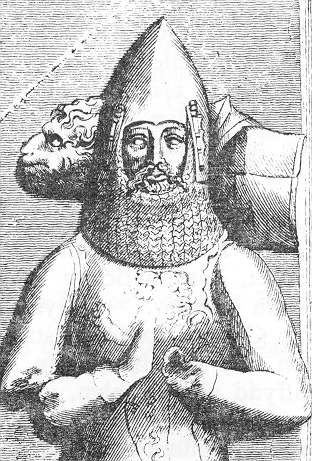
Rhys ap Gruffydd or ap Gruffudd was the ruler of the kingdom of Deheubarth in south Wales from 1155 to 1197. Today, he is commonly known as The Lord Rhys, in Welsh Yr Arglwydd Rhys, although this title may have not been used in his lifetime. He usually used the title "Proprietary Prince of Deheubarth" or "Prince of South Wales", but two documents have been discovered in which he uses the title "Prince of Wales" or "Prince of the Welsh". Rhys was one of the most successful and powerful Welsh princes, and, after the death of Owain Gwynedd of Gwynedd in 1170, the dominant power in Wales.
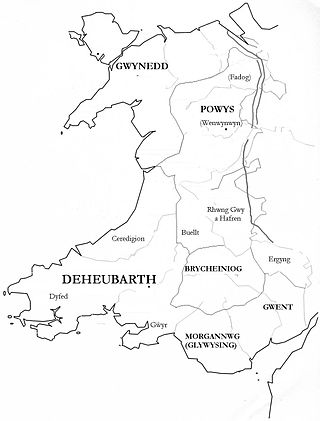
Deheubarth was a regional name for the realms of south Wales, particularly as opposed to Gwynedd. It is now used as a shorthand for the various realms united under the House of Dinefwr, but that Deheubarth itself was not considered a proper kingdom on the model of Gwynedd, Powys, or Dyfed is shown by its rendering in Latin as dextralis pars or as Britonnes dexterales and not as a named land. In the oldest British writers, Deheubarth was used for all of modern Wales to distinguish it from Hen Ogledd, the northern lands whence Cunedda originated.

Nevern is both a parish and a community in Pembrokeshire, Wales. The community includes the settlements of Felindre Farchog, Monington, Moylgrove and Bayvil. The small village lies in the Nevern valley near the Preseli Hills of the Pembrokeshire Coast National Park 2 miles (3 km) east of Newport on the B4582 road.

Rhys ap Tewdwr was a king of Deheubarth in Wales and member of the Dinefwr dynasty, a branch descended from Rhodri the Great. Following the Norman Conquest, he had to pay William the Conqueror to keep his kingdom, which lasted until the end of William's reign.

Cilgerran Castle is a 13th-century ruined castle located in Cilgerran, Pembrokeshire, Wales, near Cardigan. The first castle on the site was thought to have been built by Gerald of Windsor around 1110–1115, and it changed hands several times over the following century between English and Welsh forces. In the hands of William Marshal, 2nd Earl of Pembroke, the construction of the stone castle began after 1223.

Brycheiniog was an independent kingdom in South Wales in the Early Middle Ages. It allied with the Mercian kingdom in the post Roman era, to stabilise and control a central (Marches) area key to dominance over central Proto-England to the east and the south Welsh kingdom of Deheubarth to the west. It was conquered and pacified by the Armorican Normans between 1088 and 1095, though it remained Welsh in character. It was transformed into the Lordship of Brecknock and later formed the southern and larger part of the historic county of Brecknockshire. To its south was the Kingdom of Morgannwg.

Picton Castle is a medieval castle near Haverfordwest in the community of Uzmaston, Boulston and Slebech, Pembrokeshire, Wales. Originally built at the end of the 13th century by a Flemish knight, it later came into the hands of Sir John Wogan. The castle and gardens are now owned and managed by the Picton Castle Trust, a registered charity, for the benefit of the public. It is of unusual construction and has been remodelled several times during its history. The castle is a Grade I listed building and its gardens and park are designated at Grade II* on the Cadw/ICOMOS Register of Parks and Gardens of Special Historic Interest in Wales.

Llawhaden Castle is a ruined castle in Llawhaden, Pembrokeshire, Wales, 10 miles (16 km) east of Haverfordwest. A motte-and-bailey castle is thought to have previously occupied the site and the present structure was built by the bishops of the Diocese of St David in the 13th century. The castle was abandoned in the 16th century and some of the stone was removed for local building projects. The site is privately owned by the Lord of the Manor of Llawhaden and managed by Cadw.
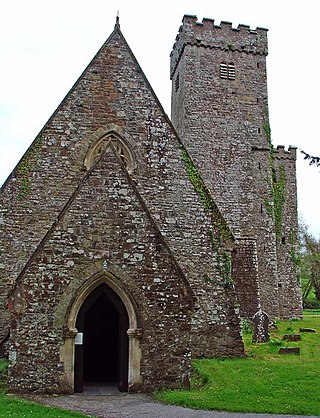
Llawhaden is a village, parish and community in mid-Pembrokeshire, West Wales, historically in the Hundred of Dungleddy. The community of Llawhaden includes the parish of Robeston Wathen, part of Narberth and the hamlet of Gelli, and had a population of 634 in 2001, increasing to 688 at the 2011 Census.
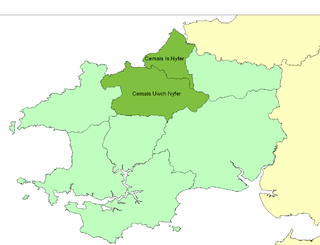
Cemais was an ancient cantref of the Kingdom of Dyfed, from the 11th century a Norman Marcher Lordship, from the 16th century a Hundred, and is now part of Pembrokeshire, Wales. It occupied the coastal area between the Teifi estuary and Fishguard, and the northern and southern slopes of the Preseli Hills, covering an area of approximately 140 square miles (360 km2). The Afon Nyfer divided it into two commotes: Cemais Is Nyfer to the north and Cemais Uwch Nyfer to the south.
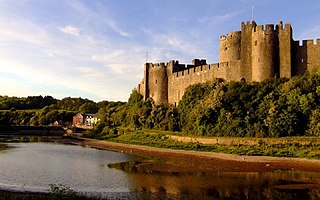
Gerald de Windsor, aliasGerald FitzWalter, was an Cymro-Norman lord who was the first Castellan of Pembroke Castle in Pembrokeshire. Son of the first Norman-French Constable of Windsor Castle, and married to a Welsh Princess daughter of the King of Deheubarth, he was in charge of the Norman forces in south-west Wales. He was also steward and governor for the Norman magnate Arnulf de Montgomery. His descendants were the FitzGerald dynasty, as well as the FitzMaurice, De Barry, and Keating dynasties of Ireland, who were elevated to the Peerage of Ireland in the 14th century. He was also the ancestor of the prominent Carew family, of Moulsford in Berkshire, the owners of Carew Castle in Pembrokeshire and of Mohuns Ottery in Devon.
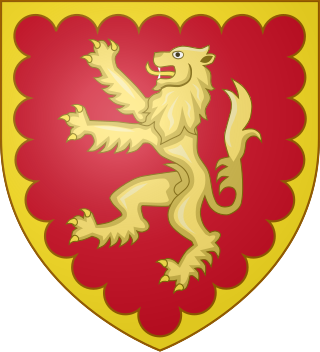
The Royal House of Dinefwr was a cadet branch of the Royal House of Gwynedd, founded by King Cadell ap Rhodri, son of Rhodri the Great. Their ancestor, Cunedda Wledig, born in late Roman Britain, was a Sub-Roman warlord who founded the Kingdom of Gwynedd during the 5th century, following the Anglo-Saxon settlement of Britain. As Celtic Britons, the House of Dinefwr was ruling before the Norman conquest, having to fight with their neighbors such as the Anglo-Saxons and Vikings, before struggling with the Normans afterwards. Many members of this family were influential in Welsh history, such as Hywel Dda, who codified Welsh law under his rule, and achieved the important title of King of the Britons, or Lord Rhys, Prince of Wales, who rebelled against Richard the Lionheart, and became one of the most powerful Welsh leaders of the Middle Ages.

The Hundred of Dewisland was a hundred in northwest Pembrokeshire, Wales. Formerly the pre-Norman cantref of Pebidiog, it included the city and the peninsula of St Davids. It was named after Dewi Sant, the Welsh name for Saint David.

Gower was an ancient marcher lordship of Deheubarth in South Wales.

Emlyn was one of the seven cantrefi of Dyfed, an ancient district of Wales, which became part of Deheubarth in around 950. It consisted of the northern part of Dyfed bordering on the River Teifi. Its southern boundary followed the ridge of the line of hills separating the Teifi valley from the valleys of the Tâf and Tywi.

Tenby Castle was a fortification standing on a headland separated by an isthmus from the town of Tenby, Pembrokeshire, Wales. The remaining stone structure dates from the 13th century but there are mentions of the castle from as early as 1153. It is a Grade II* listed building.
Einion ap Collwyn, was a Welsh prince and warrior supposed to have existed in the eleventh century. Not mentioned in medieval chronicles, he is the subject of possibly legendary or fictional writings from the sixteenth century onwards, the oldest surviving report being that of the Tudor antiquary John Leland. Some Welsh family genealogies claimed descent from Einion.
Triffyn son of Rhain was an 8th- and 9th-century king of Dyfed.

Newport Castle is a castle located in Newport, Pembrokeshire, Wales. The earliest castle on the site was built in the 13th century, and the present structure was built in the 19th century and is a private residence.
The Lordship of Brecknock was an Anglo-Norman marcher lordship located in southern central Wales.




















